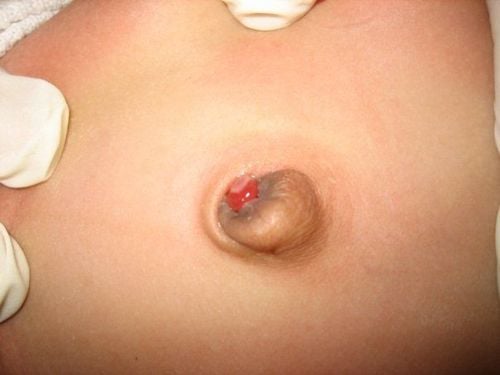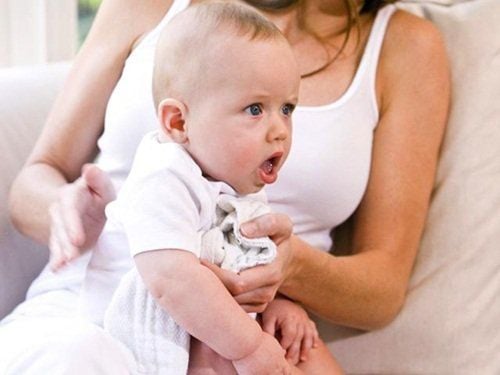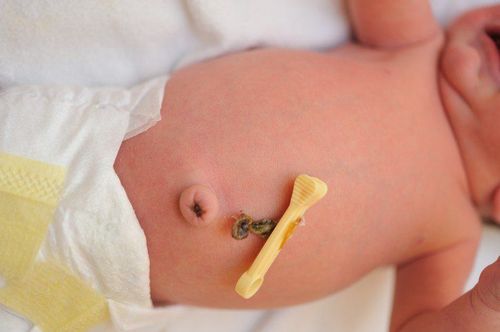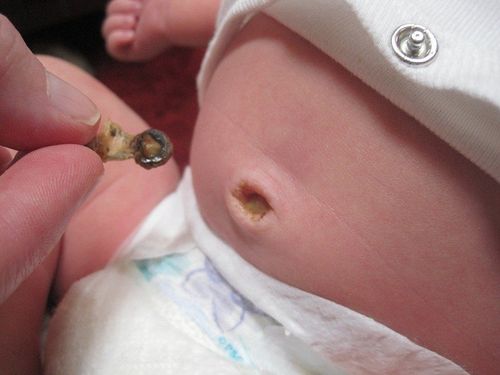This is an automatically translated article.
The article was professionally consulted by Specialist Doctor II Cao Thi Thanh - Pediatrician - Pediatrics - Neonatology Department - Vinmec Hai Phong International General HospitalNewborn's body is still weak, so the possibility of infection is very high, especially umbilical infection if not cared for properly. Umbilical infection increases the risk of very dangerous sepsis, increasing the rate of postpartum mortality. Therefore, how to take care of the navel properly, limiting the risk of infection is very important.
1. Why is it important to take care of the umbilical cord for babies?
The umbilical cord is the way to move nutrients and oxygen from the mother's placenta to the fetus, and the umbilical cord will also be connected directly to the baby's liver.If the baby does not take care of the umbilicus properly, it will lead to umbilical cord infection, causing harm:
Umbilical infection will very quickly spread to the liver, even risking sepsis, the risk of infant death very high up to 40-80%. Umbilical infection can lead to an increased risk of umbilical cord tetanus, one of the leading causes of infant mortality. Slows down umbilical cord shedding. Therefore, the umbilical cord of the newborn needs to be cared for properly, avoiding the risk of umbilical cord infection.

2. How to properly care for a newborn's navel
How to care for the umbilical cord for newborns applies to babies who have not yet shed the umbilical cord and also children who have lost the umbilical cord, the umbilical cord still has discharge or infection.Prepare tools:
Sterile cotton sticks or sterile cotton. Sterile gauze. 70 degrees alcohol umbilical cord cleaning solution or 1% eosin solution. Navel band. Steps to take care of a newborn's umbilical cord:
First, caregivers need to wash their hands, preferably with antibacterial soap. Then remove your baby's old umbilical cord and wash your hands again. Then, with a sterile gauze hand, gently lift the umbilical cord, observe whether the navel is red, oozing pus, bleeding or foul-smelling, the skin around the umbilicus is red. Next, you use a sterile cotton stick soaked in an antiseptic solution to disinfect the umbilicus in the order from the umbilical stump, umbilicus, and umbilical cord cross section. Disinfect the skin around the umbilical cord from the base of the umbilicus to 5cm wide with an antiseptic solution. Finally, if the navel is fresh, bandage the umbilicus with thin gauze, and if the umbilicus is dry, do not bandage the umbilical cord to open it. Note:
Normally, the umbilical cord of a newborn will fall off within 7 to 10 days after birth and after 15 days, the umbilical cord must be completely healed, but there are also some cases where the umbilical cord falls off longer but if there is no Signs of infection are nothing to worry about. All you need to do is keep the navel and surrounding area clean and dry until the stump falls off. 24 - 48 hours after birth, when the umbilical section is dry, the umbilical cord clamp can be safely removed from the umbilical cord. The infant should have the umbilical cord removed at the hospital, before the infant is discharged home. Clamping the umbilical cord can interfere with diaper changes at home and can be pulled up, causing damage to the umbilical cord, causing pain for the baby. When the umbilical cord is dry, leave it open, allowing the umbilical cord to be exposed to air to help the umbilical cord fall off faster. Wrap diapers below the navel, after the baby has defecated and urinated, the diaper needs to be changed immediately. When the umbilical cord has not fallen off, avoid putting the baby in the bath as this will wet the umbilical cord, the bath water may be unsanitary and may cause an infection of the umbilicus. Use a small soft towel to wipe the young person, after wiping the user use a cotton swab to wipe the baby's navel foot. When the umbilical cord falls off, the baby can be dipped in the tub. It is necessary to continue taking care of the umbilical cord after the umbilicus has fallen off until the umbilical cord is dry and no longer exudes. If it is not necessary, do not touch your baby's umbilical cord. In case the baby appears a little bit of dry blood at the base of the umbilicus, it is normal for parents to not be too worried.

3. When to take your child to the hospital?
Umbilical InfectionSigns of an Infection:
Newborn's umbilical cord leg is red and swollen. Newborn umbilical cord secretes a lot of fluid, has a bad smell. Press the area around the navel of a fussy baby. Redness of the skin around the navel. Navel bleeding. In addition, some other accompanying signs such as:
The child has a high fever over 38 degrees Celsius, the baby has rapid breathing (breathing rate over 60 times/minute), the baby has jaundice... Umbilical granuloma: If the umbilical leg is seen prolonged yellow discharge without signs of swelling, heat, redness, the child does not have a fever, the child may have umbilical granuloma. Persistent umbilical cord bleeding: If the umbilical cord is bleeding profusely and for a long time, this may be a sign of a blood clotting disorder. When realizing that a child has the above signs, parents need to take the child to a medical facility for examination and early treatment to avoid dangerous complications for the child.
Take care of the newborn umbilical cord properly to avoid the risk of umbilical cord infection, thereby reducing the risk of life-threatening sepsis of the baby. In the process of taking care of the baby's umbilical cord, parents regularly check and detect abnormal signs to promptly take the child to a medical facility right away.
As a key area of Vinmec Health system, Pediatrics Department always brings satisfaction to customers and is highly appreciated by industry experts with:
Gathering a team of top doctors and nurses in Pediatrics : consists of leading experts with high professional qualifications (professors, associate professors, doctorates, masters), experienced, worked at major hospitals such as Bach Mai, 108.. Doctors All doctors are well-trained, professional, conscientious, knowledgeable about young psychology. Besides domestic specialists, the Pediatrics Department also has the participation of foreign experts (Japan, Singapore, Australia, USA) who are always pioneers in applying the latest and most effective treatment regimens. Comprehensive services: In the field of Pediatrics, Vinmec provides a series of continuous medical examination and treatment services from Newborn to Pediatric and Vaccine,... according to international standards to help parents take care of their baby's health from birth to childhood. from birth to adulthood Specialized techniques: Vinmec has successfully deployed many specialized techniques to make the treatment of difficult diseases in Pediatrics more effective: neurosurgery - skull surgery, stem cell transplantation. blood in cancer treatment. Professional care: In addition to understanding children's psychology, Vinmec also pays special attention to the children's play space, helping them to have fun and get used to the hospital's environment, cooperate in treatment, improve the efficiency of medical treatment.
Please dial HOTLINE for more information or register for an appointment HERE. Download MyVinmec app to make appointments faster and to manage your bookings easily.














